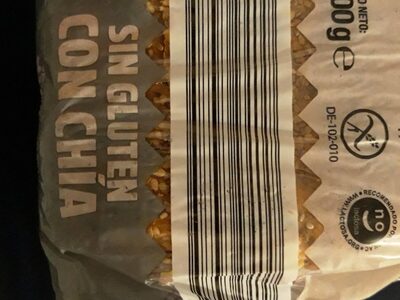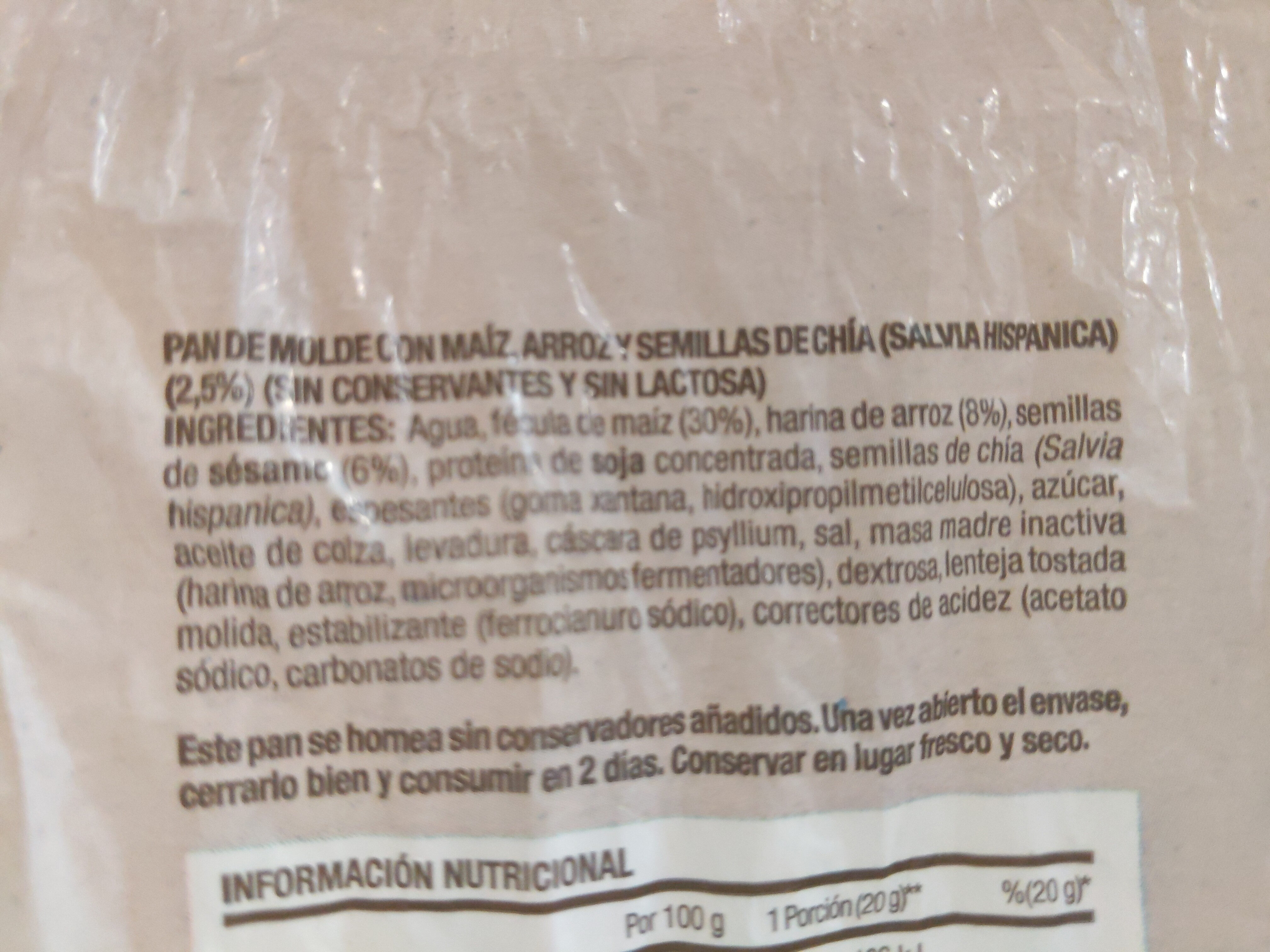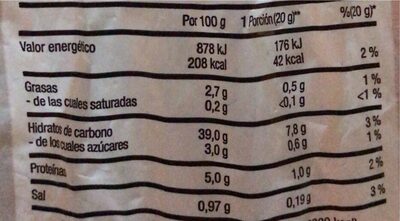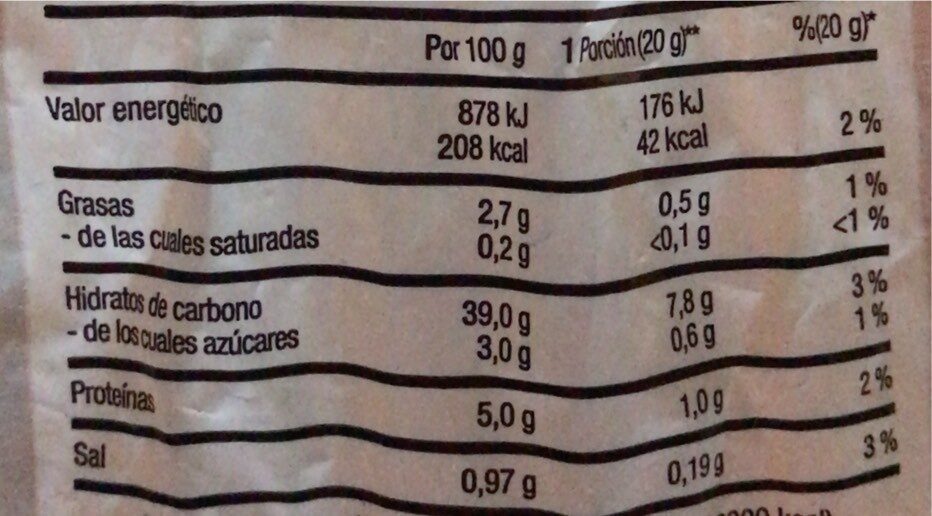Help us make food transparency the norm!
As a non-profit organization, we depend on your donations to continue informing consumers around the world about what they eat.
The food revolution starts with you!
Pan de molde sin gluten - el horno de aldi - 400 g
Pan de molde sin gluten - el horno de aldi - 400 g
Ambiguous barcode: This product has a Restricted Circulation Number barcode for products within a company. This means that different producers and stores can use the same barcode for different products.
×
This product page is not complete. You can help to complete it by editing it and adding more data from the photos we have, or by taking more photos using the app for Android or iPhone/iPad. Thank you!
×
Barra-kodea: 24097475
Kopurua: 400 g
Markak: el horno de aldi
Kategoriak: en:Plant-based foods and beverages, en:Plant-based foods, en:Cereals and potatoes, en:Specific products, en:Products for specific diets, en:Breads, en:Products without gluten, en:Gluten-free breads, en:Sliced breads, en:Gluten-free sliced breads
Etiketak, ziurtagiriak, sariak: en:No gluten, en:No preservatives, en:No lactose
Dendak: Aldi
Saltzen diren herrialdeak: Espainia
Matching with your preferences
Health
Osagaiak
-
28 ingredients
: Agua, fécula de maiz (30%), harina de arroz (8%), semillas de sésamo (6%), proteina de soja concentrada, semillas de chía (Salvia hispanica), epesantes (goma xantana, hidroxipropilmetilcelulosa), azúcar, aceite de colza, levadura, cáscara de psyllium, sal, masa madre inactiva (harina de arroz, microorganismos fermentadores), dextrosa, lenteja tostada molida, estabilizante (ferrocianuro sódico), correctores de acidez (acetato sódico, carbonatos de sodio), Este pan se hornea sin conservadores añadidos,Una vez abierto el envase, cerrarlo bien y consumir en 2 diasAlergenoak: en:Sesame seeds
Food processing
-
Ultra processed foods
Elements that indicate the product is in the 4 - Ultra prozesatutako elikagaiak eta edariak group:
- Gehigarria: E415
- Gehigarria: E464
- Osagaia: Dextrose
- Osagaia: Glukosa
Food products are classified into 4 groups according to their degree of processing:
- Prozesatu gabeko edo ahalik eta gutxien prozesatutako elikagaiak
- Sukaldaritzako osagaiak prozesatu
- Prozesatutako jakiak
- Ultra processed foods
The determination of the group is based on the category of the product and on the ingredients it contains.
Gehigarriak
-
E262
Sodium acetate: Sodium acetate, CH3COONa, also abbreviated NaOAc, is the sodium salt of acetic acid. This colorless deliquescent salt has a wide range of uses.Source: Wikipedia (Ingeles)
-
E262i - Sodio azetato
Sodium acetate: Sodium acetate, CH3COONa, also abbreviated NaOAc, is the sodium salt of acetic acid. This colorless deliquescent salt has a wide range of uses.Source: Wikipedia (Ingeles)
-
E415
Xanthan gum: Xanthan gum -- is a polysaccharide with many industrial uses, including as a common food additive. It is an effective thickening agent and stabilizer to prevent ingredients from separating. It can be produced from simple sugars using a fermentation process, and derives its name from the species of bacteria used, Xanthomonas campestris.Source: Wikipedia (Ingeles)
-
E464
Hypromellose: Hypromellose -INN-, short for hydroxypropyl methylcellulose -HPMC-, is a semisynthetic, inert, viscoelastic polymer used as eye drops, as well as an excipient and controlled-delivery component in oral medicaments, found in a variety of commercial products.As a food additive, hypromellose is an emulsifier, thickening and suspending agent, and an alternative to animal gelatin. Its Codex Alimentarius code -E number- is E464.Source: Wikipedia (Ingeles)
-
E500
Sodium carbonate: Sodium carbonate, Na2CO3, -also known as washing soda, soda ash and soda crystals, and in the monohydrate form as crystal carbonate- is the water-soluble sodium salt of carbonic acid. It most commonly occurs as a crystalline decahydrate, which readily effloresces to form a white powder, the monohydrate. Pure sodium carbonate is a white, odorless powder that is hygroscopic -absorbs moisture from the air-. It has a strongly alkaline taste, and forms a moderately basic solution in water. Sodium carbonate is well known domestically for its everyday use as a water softener. Historically it was extracted from the ashes of plants growing in sodium-rich soils, such as vegetation from the Middle East, kelp from Scotland and seaweed from Spain. Because the ashes of these sodium-rich plants were noticeably different from ashes of timber -used to create potash-, they became known as "soda ash". It is synthetically produced in large quantities from salt -sodium chloride- and limestone by a method known as the Solvay process. The manufacture of glass is one of the most important uses of sodium carbonate. Sodium carbonate acts as a flux for silica, lowering the melting point of the mixture to something achievable without special materials. This "soda glass" is mildly water-soluble, so some calcium carbonate is added to the melt mixture to make the glass produced insoluble. This type of glass is known as soda lime glass: "soda" for the sodium carbonate and "lime" for the calcium carbonate. Soda lime glass has been the most common form of glass for centuries. Sodium carbonate is also used as a relatively strong base in various settings. For example, it is used as a pH regulator to maintain stable alkaline conditions necessary for the action of the majority of photographic film developing agents. It acts as an alkali because when dissolved in water, it dissociates into the weak acid: carbonic acid and the strong alkali: sodium hydroxide. This gives sodium carbonate in solution the ability to attack metals such as aluminium with the release of hydrogen gas.It is a common additive in swimming pools used to raise the pH which can be lowered by chlorine tablets and other additives which contain acids. In cooking, it is sometimes used in place of sodium hydroxide for lyeing, especially with German pretzels and lye rolls. These dishes are treated with a solution of an alkaline substance to change the pH of the surface of the food and improve browning. In taxidermy, sodium carbonate added to boiling water will remove flesh from the bones of animal carcasses for trophy mounting or educational display. In chemistry, it is often used as an electrolyte. Electrolytes are usually salt-based, and sodium carbonate acts as a very good conductor in the process of electrolysis. In addition, unlike chloride ions, which form chlorine gas, carbonate ions are not corrosive to the anodes. It is also used as a primary standard for acid-base titrations because it is solid and air-stable, making it easy to weigh accurately.Source: Wikipedia (Ingeles)
-
E535
Sodium ferrocyanide: Sodium ferrocyanide is the sodium salt of the coordination compound of formula [Fe-CN-6]4−. In its hydrous form, Na4Fe-CN-6 · 10 H2O -sodium ferrocyanide decahydrate-, it is sometimes known as yellow prussiate of soda. It is a yellow crystalline solid that is soluble in water and insoluble in alcohol. The yellow color is the color of ferrocyanide anion. Despite the presence of the cyanide ligands, sodium ferrocyanide has low toxicity -acceptable daily intake 0–0.025 mg/kg body weight-. The ferrocyanides are less toxic than many salts of cyanide, because they tend not to release free cyanide. However, like all ferrocyanide salt solutions, addition of an acid can result in the production of hydrogen cyanide gas, which is toxic.Source: Wikipedia (Ingeles)
Ingredients analysis
-
en:Palm oil free
No ingredients containing palm oil detected
Unrecognized ingredients: es:epesantes, es:cascara-de-psyllium, es:microorganismos-fermentadores, es:este-pan-se-hornea-sin-conservadores-anadidos, es:una-vez-abierto-el-envase, es:cerrarlo-bien-y-consumir-en-2-diasSome ingredients could not be recognized.
We need your help!
You can help us recognize more ingredients and better analyze the list of ingredients for this product and others:
- Edit this product page to correct spelling mistakes in the ingredients list, and/or to remove ingredients in other languages and sentences that are not related to the ingredients.
- Add new entries, synonyms or translations to our multilingual lists of ingredients, ingredient processing methods, and labels.
If you would like to help, join the #ingredients channel on our Slack discussion space and/or learn about ingredients analysis on our wiki. Thank you!
-
en:Vegan status unknown
Unrecognized ingredients: es:epesantes, es:cascara-de-psyllium, es:Masa madre inactiva, es:microorganismos-fermentadores, es:este-pan-se-hornea-sin-conservadores-anadidos, es:una-vez-abierto-el-envase, es:cerrarlo-bien-y-consumir-en-2-diasSome ingredients could not be recognized.
We need your help!
You can help us recognize more ingredients and better analyze the list of ingredients for this product and others:
- Edit this product page to correct spelling mistakes in the ingredients list, and/or to remove ingredients in other languages and sentences that are not related to the ingredients.
- Add new entries, synonyms or translations to our multilingual lists of ingredients, ingredient processing methods, and labels.
If you would like to help, join the #ingredients channel on our Slack discussion space and/or learn about ingredients analysis on our wiki. Thank you!
-
en:Vegetarian status unknown
Unrecognized ingredients: es:epesantes, es:cascara-de-psyllium, es:Masa madre inactiva, es:microorganismos-fermentadores, es:este-pan-se-hornea-sin-conservadores-anadidos, es:una-vez-abierto-el-envase, es:cerrarlo-bien-y-consumir-en-2-diasSome ingredients could not be recognized.
We need your help!
You can help us recognize more ingredients and better analyze the list of ingredients for this product and others:
- Edit this product page to correct spelling mistakes in the ingredients list, and/or to remove ingredients in other languages and sentences that are not related to the ingredients.
- Add new entries, synonyms or translations to our multilingual lists of ingredients, ingredient processing methods, and labels.
If you would like to help, join the #ingredients channel on our Slack discussion space and/or learn about ingredients analysis on our wiki. Thank you!
-
Details of the analysis of the ingredients
We need your help!
Some ingredients could not be recognized.
We need your help!
You can help us recognize more ingredients and better analyze the list of ingredients for this product and others:
- Edit this product page to correct spelling mistakes in the ingredients list, and/or to remove ingredients in other languages and sentences that are not related to the ingredients.
- Add new entries, synonyms or translations to our multilingual lists of ingredients, ingredient processing methods, and labels.
If you would like to help, join the #ingredients channel on our Slack discussion space and/or learn about ingredients analysis on our wiki. Thank you!
: Agua, fécula de maiz 30%, harina de arroz 8%, semillas de sésamo 6%, proteina de soja, semillas de chía (Salvia hispanica), epesantes (goma xantana, hidroxipropilmetilcelulosa), azúcar, aceite de colza, levadura, cáscara de psyllium, sal, masa madre inactiva (harina de arroz, microorganismos fermentadores), dextrosa, lenteja, estabilizante (ferrocianuro sódico), correctores de acidez (acetato sódico, carbonatos de sodio), Este pan se hornea sin conservadores añadidos, Una vez abierto el envase, cerrarlo bien y consumir en 2 dias- Agua -> en:water - vegan: yes - vegetarian: yes - ciqual_food_code: 18066 - percent_min: 30 - percent_max: 56
- fécula de maiz -> en:corn-starch - vegan: yes - vegetarian: yes - ciqual_food_code: 9510 - percent_min: 30 - percent: 30 - percent_max: 30
- harina de arroz -> en:rice-flour - vegan: yes - vegetarian: yes - ciqual_food_code: 9520 - percent_min: 8 - percent: 8 - percent_max: 8
- semillas de sésamo -> en:sesame-seeds - vegan: yes - vegetarian: yes - ciqual_food_code: 15010 - percent_min: 6 - percent: 6 - percent_max: 6
- proteina de soja -> en:soy-protein - vegan: yes - vegetarian: yes - ciqual_food_code: 20591 - percent_min: 0 - percent_max: 6
- semillas de chía -> en:chia-seed - vegan: yes - vegetarian: yes - percent_min: 0 - percent_max: 6
- Salvia hispanica -> en:chia - vegan: yes - vegetarian: yes - percent_min: 0 - percent_max: 6
- epesantes -> es:epesantes - percent_min: 0 - percent_max: 6
- goma xantana -> en:e415 - vegan: yes - vegetarian: yes - percent_min: 0 - percent_max: 6
- hidroxipropilmetilcelulosa -> en:e464 - vegan: yes - vegetarian: yes - percent_min: 0 - percent_max: 3
- azúcar -> en:sugar - vegan: yes - vegetarian: yes - ciqual_proxy_food_code: 31016 - percent_min: 0 - percent_max: 3
- aceite de colza -> en:colza-oil - vegan: yes - vegetarian: yes - from_palm_oil: no - ciqual_food_code: 17130 - percent_min: 0 - percent_max: 3
- levadura -> en:yeast - vegan: yes - vegetarian: yes - percent_min: 0 - percent_max: 3
- cáscara de psyllium -> es:cascara-de-psyllium - percent_min: 0 - percent_max: 3
- sal -> en:salt - vegan: yes - vegetarian: yes - ciqual_food_code: 11058 - percent_min: 0 - percent_max: 0.97
- masa madre inactiva -> es:masa-madre-inactiva - percent_min: 0 - percent_max: 0.97
- harina de arroz -> en:rice-flour - vegan: yes - vegetarian: yes - ciqual_food_code: 9520 - percent_min: 0 - percent_max: 0.97
- microorganismos fermentadores -> es:microorganismos-fermentadores - percent_min: 0 - percent_max: 0.485
- dextrosa -> en:dextrose - vegan: yes - vegetarian: yes - ciqual_proxy_food_code: 31016 - percent_min: 0 - percent_max: 0.97
- lenteja -> en:lentils - vegan: yes - vegetarian: yes - ciqual_food_code: 20505 - percent_min: 0 - percent_max: 0.97
- estabilizante -> en:stabiliser - percent_min: 0 - percent_max: 0.97
- ferrocianuro sódico -> en:e535 - vegan: yes - vegetarian: yes - percent_min: 0 - percent_max: 0.97
- correctores de acidez -> en:acidity-regulator - percent_min: 0 - percent_max: 0.97
- acetato sódico -> en:e262i - vegan: yes - vegetarian: yes - percent_min: 0 - percent_max: 0.97
- carbonatos de sodio -> en:e500 - vegan: yes - vegetarian: yes - percent_min: 0 - percent_max: 0.485
- Este pan se hornea sin conservadores añadidos -> es:este-pan-se-hornea-sin-conservadores-anadidos - percent_min: 0 - percent_max: 0.97
- Una vez abierto el envase -> es:una-vez-abierto-el-envase - percent_min: 0 - percent_max: 0.97
- cerrarlo bien y consumir en 2 dias -> es:cerrarlo-bien-y-consumir-en-2-dias - percent_min: 0 - percent_max: 0.97
Elikadura
-
Average nutritional quality
⚠ ️Abisua: zuntz kopurua ez dago zehaztuta, ezin izan dute kontuan izan kalifikaziorako izan dezaketen ekarpen positiboa.⚠ ️Warning: the amount of fruits, vegetables and nuts is not specified on the label, it was estimated from the list of ingredients: 1This product is not considered a beverage for the calculation of the Nutri-Score.
Positive points: 3
- Proteinak: 3 / 5 (balioa: 5, rounded value: 5)
- Fiber: 0 / 5 (balioa: 0, rounded value: 0)
- Fruits, vegetables, nuts, and colza/walnut/olive oils: 0 / 5 (balioa: 1.26953125, rounded value: 1.3)
Negative points: 6
- Energia: 2 / 10 (balioa: 870, rounded value: 870)
- Azukreak: 0 / 10 (balioa: 3, rounded value: 3)
- Gantz saturatua: 0 / 10 (balioa: 0.2, rounded value: 0.2)
- Sodioa: 4 / 10 (balioa: 388, rounded value: 388)
The points for proteins are counted because the negative points are less than 11.
Nutritional score: (6 - 3)
Nutri-Score:
-
Nutrient levels
-
Koipe in low quantity (2.7%)
What you need to know- A high consumption of fat, especially saturated fats, can raise cholesterol, which increases the risk of heart diseases.
Recommendation: Limit the consumption of fat and saturated fat- Choose products with lower fat and saturated fat content.
-
Gantz-azido ase in low quantity (0.2%)
What you need to know- A high consumption of fat, especially saturated fats, can raise cholesterol, which increases the risk of heart diseases.
Recommendation: Limit the consumption of fat and saturated fat- Choose products with lower fat and saturated fat content.
-
Azukre in low quantity (3%)
What you need to know- A high consumption of sugar can cause weight gain and tooth decay. It also augments the risk of type 2 diabetes and cardio-vascular diseases.
Recommendation: Limit the consumption of sugar and sugary drinks- Sugary drinks (such as sodas, fruit beverages, and fruit juices and nectars) should be limited as much as possible (no more than 1 glass a day).
- Choose products with lower sugar content and reduce the consumption of products with added sugars.
-
Gatz arrunt in moderate quantity (0.97%)
What you need to know- A high consumption of salt (or sodium) can cause raised blood pressure, which can increase the risk of heart disease and stroke.
- Many people who have high blood pressure do not know it, as there are often no symptoms.
- Most people consume too much salt (on average 9 to 12 grams per day), around twice the recommended maximum level of intake.
Recommendation: Limit the consumption of salt and salted food- Reduce the quantity of salt used when cooking, and don't salt again at the table.
- Limit the consumption of salty snacks and choose products with lower salt content.
-
-
Nutrition facts
Nutrition facts As sold
for 100 g / 100 mlCompared to: en:Gluten-free sliced breads Energia 870 kj
(208 kcal)-% 23 Koipe 2,7 g -% 48 Gantz-azido ase 0,2 g -% 80 Carbohydrates 39 g -% 17 Azukre 3 g -% 16 Fiber ? Proteina 5 g +% 45 Gatz arrunt 0,97 g -% 23 Fruits‚ vegetables‚ nuts and rapeseed‚ walnut and olive oils (estimate from ingredients list analysis) 1,27 %
Ingurumena
-
Eco-Score B - Ingurumen-eragin txikia
The Eco-Score is an experimental score that summarizes the environmental impacts of food products.→ The Eco-Score was initially developped for France and it is being extended to other European countries. The Eco-Score formula is subject to change as it is regularly improved to make it more precise and better suited to each country.Life cycle analysis
-
Average impact of products of the same category: A (Score: 90/100)
Kategoria: Sandwich loaf
Kategoria: Sandwich loaf
- PEF environmental score: 0.19 (the lower the score, the lower the impact)
- including impact on climate change: 1.76 kg CO2 eq/kg of product
Stage Impact Agriculture
58.9 %Processing
23.6 %Ontziratzea
12.2 %Transportation
4.8 %Distribution
0.4 %Consumption
0.0 %
Bonuses and maluses
-
Missing origins of ingredients information
Malus: -5
⚠ ️ The origins of the ingredients of this product are not indicated.
If they are indicated on the packaging, you can modify the product sheet and add them.
If you are the manufacturer of this product, you can send us the information with our free platform for producers.
-
Missing packaging information for this product
Malus: -15
⚠ ️ The information about the packaging of this product is not filled in.⚠ ️ For a more precise calculation of the Eco-Score, you can modify the product page and add them.
If you are the manufacturer of this product, you can send us the information with our free platform for producers.
Eco-Score for this product
-
Impact for this product: B (Score: 70/100)
Produktua: Pan de molde sin gluten - el horno de aldi - 400 g
Life cycle analysis score: 90
Sum of bonuses and maluses: -20
Final score: 70/100
-
Carbon footprint
-
Equal to driving 0.9 km in a petrol car
176 g CO² per 100g of product
The carbon emission figure comes from ADEME's Agribalyse database, for the category: Sandwich loaf (Source: ADEME Agribalyse Database)
Stage Impact Agriculture
59.3 %Processing
17.8 %Ontziratzea
16.0 %Transportation
6.7 %Distribution
0.3 %Consumption
0.0 %
Ontziratzea
-
Missing packaging information for this product
⚠ ️ The information about the packaging of this product is not filled in.Take a photo of the recycling information Take a photo of the recycling information
Transportation
-
Origins of ingredients
Missing origins of ingredients information
⚠ ️ The origins of the ingredients of this product are not indicated.
If they are indicated on the packaging, you can modify the product sheet and add them.
If you are the manufacturer of this product, you can send us the information with our free platform for producers.Add the origins of ingredients for this product Add the origins of ingredients for this product
Report a problem
-
Incomplete or incorrect information?
Category, labels, ingredients, allergens, nutritional information, photos etc.
If the information does not match the information on the packaging, please complete or correct it. Open Food Facts is a collaborative database, and every contribution is useful for all.
Datuen iturria
Product added on by elcoco
Last edit of product page on by inf.
Produktuaren orria -gatik editatua ecoscore-impact-estimator, elcoco.202580d8b80c41502f2bd365e81f645a, jmperson1976, kiliweb, manzamingo, noxin, org-app-elcoco, roboto-app, teolemon, thaialagata, yuka.CbsabO-BL8wGGfTt7bsL-Ae4M-XZG8UIMiIuog, yuka.VnA4ZFBvQUtxdUF5c2NadTl5MksxZXB2M3JIMlYyaVZCc2dnSVE9PQ, yuka.sY2b0xO6T85zoF3NwEKvlhdYCdXOuhTObCPnwWKN4PO2f8DkUNQs2ZnmK6s, yuka.sY2b0xO6T85zoF3NwEKvllFHcoDujijdGCf5o3-SwPbWDZ7CaO1957HdYqs, yuka.sY2b0xO6T85zoF3NwEKvlm17Yv6Emyn-LCzfiWSI49S2C4bhfN99-a_eLqg, yuka.sY2b0xO6T85zoF3NwEKvlnJDd4virG2ZCBbUtUaM_I6cBZbPR-BZuKurHKo.










